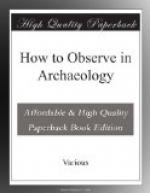VI. ROMAN
Hellenistic ware (2) is forerunner of Samian or Aretine red pottery with moulded designs. Very widespread in Greece in Imperial days.
VII. BYZANTINE AGE
Remains as far as the scope of this section is concerned are few. Fragments of pottery may be found at Sparta. These bear strong resemblance to the contemporary wares found in Egypt belonging to the early Mohammedan period.
Transparent lustrous glaze. Ground usually pale yellow or cream, sometimes pale green. Designs childish in character. Lions, birds, human figures painted in brown under the glaze or incised through.
CHAPTER III
ASIA MINOR
[See the diagrams of pottery, Illustration V: Asia minor pottery]
1. Introductory.
Travellers are more likely to make new discoveries elsewhere than on the actual sites of ancient towns and villages. In many cases the site is found to be entirely bare of all remains except sometimes small fragments of pottery. In general, inscribed and other stones have been carried away to serve as building material for mosques, houses, fountains, bridges, &c., or as headstones for graves in cemeteries or for other utilitarian purposes. It is, therefore, in and near modern villages and towns that inscriptions are chiefly to be found, as well as smaller antiquities, such as clay tablets, pots or fragments of them, terra-cotta figures, coins, and so forth. The smaller articles may sometimes be found in the bazaars, but they are usually in the hands of individuals.
It should not be assumed that inscriptions which are exposed to public view have all been copied; moreover, new stones are constantly being turned up, especially where building is going on and where there are old sites or cemeteries close at hand. Great numbers of inscribed stones are hidden away in private dwellings, where they are difficult of discovery and of access. Travellers should take advantage of opportunities that may offer of examining antiquities in private houses, and of visiting sites or monuments about which information may be received, particularly if they are a little off the beaten track. Reward will often come in the shape of valuable discoveries, of which many remain to be made. Cilicia in particular has been imperfectly explored, and interesting monuments and inscriptions, particularly Hittite, may be found there.
2. Pottery Fabrics.
It is not yet possible to describe fully or accurately
the succession
of styles, or even to assign all known fabrics to
their proper
periods. For this reason, even the most fragmentary
specimens are of
interest, provided only that:
(1) the outer surface is fairly
well preserved,
(2) the place of discovery is known.




